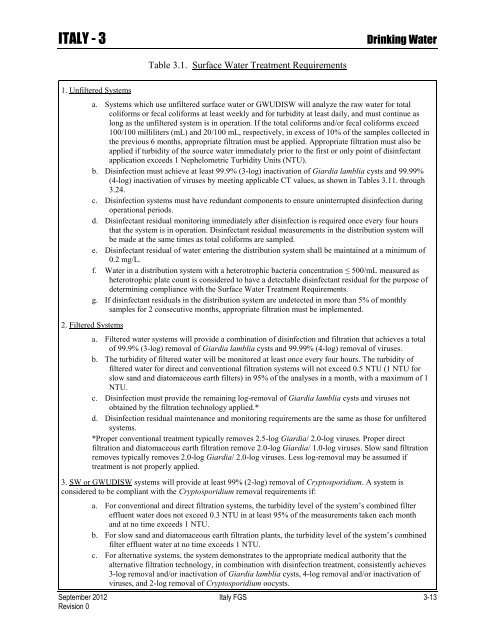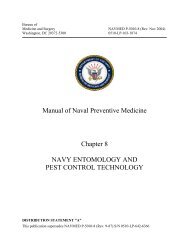ENVIRONMENTAL FINAL GOVERNING STANDARDS ITALY
ENVIRONMENTAL FINAL GOVERNING STANDARDS ITALY
ENVIRONMENTAL FINAL GOVERNING STANDARDS ITALY
Create successful ePaper yourself
Turn your PDF publications into a flip-book with our unique Google optimized e-Paper software.
<strong>ITALY</strong> - 3 Drinking Water<br />
1. Unfiltered Systems<br />
Table 3.1. Surface Water Treatment Requirements<br />
a. Systems which use unfiltered surface water or GWUDISW will analyze the raw water for total<br />
coliforms or fecal coliforms at least weekly and for turbidity at least daily, and must continue as<br />
long as the unfiltered system is in operation. If the total coliforms and/or fecal coliforms exceed<br />
100/100 milliliters (mL) and 20/100 mL, respectively, in excess of 10% of the samples collected in<br />
the previous 6 months, appropriate filtration must be applied. Appropriate filtration must also be<br />
applied if turbidity of the source water immediately prior to the first or only point of disinfectant<br />
application exceeds 1 Nephelometric Turbidity Units (NTU).<br />
b. Disinfection must achieve at least 99.9% (3-log) inactivation of Giardia lamblia cysts and 99.99%<br />
(4-log) inactivation of viruses by meeting applicable CT values, as shown in Tables 3.11. through<br />
3.24.<br />
c. Disinfection systems must have redundant components to ensure uninterrupted disinfection during<br />
operational periods.<br />
d. Disinfectant residual monitoring immediately after disinfection is required once every four hours<br />
that the system is in operation. Disinfectant residual measurements in the distribution system will<br />
be made at the same times as total coliforms are sampled.<br />
e. Disinfectant residual of water entering the distribution system shall be maintained at a minimum of<br />
0.2 mg/L.<br />
f. Water in a distribution system with a heterotrophic bacteria concentration ≤ 500/mL measured as<br />
heterotrophic plate count is considered to have a detectable disinfectant residual for the purpose of<br />
determining compliance with the Surface Water Treatment Requirements.<br />
g. If disinfectant residuals in the distribution system are undetected in more than 5% of monthly<br />
samples for 2 consecutive months, appropriate filtration must be implemented.<br />
2. Filtered Systems<br />
a. Filtered water systems will provide a combination of disinfection and filtration that achieves a total<br />
of 99.9% (3-log) removal of Giardia lamblia cysts and 99.99% (4-log) removal of viruses.<br />
b. The turbidity of filtered water will be monitored at least once every four hours. The turbidity of<br />
filtered water for direct and conventional filtration systems will not exceed 0.5 NTU (1 NTU for<br />
slow sand and diatomaceous earth filters) in 95% of the analyses in a month, with a maximum of 1<br />
NTU.<br />
c. Disinfection must provide the remaining log-removal of Giardia lamblia cysts and viruses not<br />
obtained by the filtration technology applied.*<br />
d. Disinfection residual maintenance and monitoring requirements are the same as those for unfiltered<br />
systems.<br />
*Proper conventional treatment typically removes 2.5-log Giardia/ 2.0-log viruses. Proper direct<br />
filtration and diatomaceous earth filtration remove 2.0-log Giardia/ 1.0-log viruses. Slow sand filtration<br />
removes typically removes 2.0-log Giardia/ 2.0-log viruses. Less log-removal may be assumed if<br />
treatment is not properly applied.<br />
3. SW or GWUDISW systems will provide at least 99% (2-log) removal of Cryptosporidium. A system is<br />
considered to be compliant with the Cryptosporidium removal requirements if:<br />
a. For conventional and direct filtration systems, the turbidity level of the system’s combined filter<br />
effluent water does not exceed 0.3 NTU in at least 95% of the measurements taken each month<br />
and at no time exceeds 1 NTU.<br />
b. For slow sand and diatomaceous earth filtration plants, the turbidity level of the system’s combined<br />
filter effluent water at no time exceeds 1 NTU.<br />
c. For alternative systems, the system demonstrates to the appropriate medical authority that the<br />
alternative filtration technology, in combination with disinfection treatment, consistently achieves<br />
3-log removal and/or inactivation of Giardia lamblia cysts, 4-log removal and/or inactivation of<br />
viruses, and 2-log removal of Cryptosporidium oocysts.<br />
September 2012 Italy FGS 3-13<br />
Revision 0
















